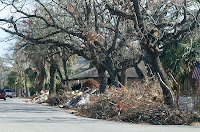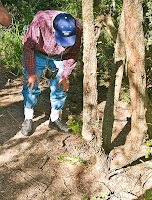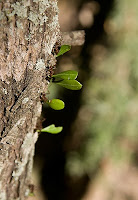Location: Galveston Island, TX
 Just short of one year ago, I visited Galveston for the first time and returned now to see how it withstood Hurricane Ike. Galveston, a barrier island on the gulf coast south of Houston, is known for historically bad hurricanes, the solid seawall that protects them now, suspected pirate booty, and Glen Campbell's 1969 hit. Two months ago, in September 2008, Galveston was again a hurricane magnet as the enormous storm, Ike, made landfall.
Just short of one year ago, I visited Galveston for the first time and returned now to see how it withstood Hurricane Ike. Galveston, a barrier island on the gulf coast south of Houston, is known for historically bad hurricanes, the solid seawall that protects them now, suspected pirate booty, and Glen Campbell's 1969 hit. Two months ago, in September 2008, Galveston was again a hurricane magnet as the enormous storm, Ike, made landfall.
 In Livingston, where Ike sat spinning for hours, fallen trees and wind did most of the damage. The drive to Galveston was similar -- uprooted trees, some huge, were still lying where they had fallen, branches and twigs still littered lots and roadsides, and FEMA dump trucks could be seen hauling it all away. Many roofs were partially covered with blue tarps, waiting for repairs. Large, high business signs took a big hit -- they were often cracked and broken, and there was not a single McDonald's golden arches sign along our route that survived intact.
In Livingston, where Ike sat spinning for hours, fallen trees and wind did most of the damage. The drive to Galveston was similar -- uprooted trees, some huge, were still lying where they had fallen, branches and twigs still littered lots and roadsides, and FEMA dump trucks could be seen hauling it all away. Many roofs were partially covered with blue tarps, waiting for repairs. Large, high business signs took a big hit -- they were often cracked and broken, and there was not a single McDonald's golden arches sign along our route that survived intact.
 Once we got to Galveston, that changed. There was still a lot of tree debris everywhere you looked, but now broken furniture, pieces of wallboard, appliances, and carpet were added to the piles along the roads. I had expected to see many destroyed buildings, but most of them deceptively look rather normal. The damage here was not caused just by the high wind, but also by the storm surge water that almost swept across the entire island, flooding most buildings.
Once we got to Galveston, that changed. There was still a lot of tree debris everywhere you looked, but now broken furniture, pieces of wallboard, appliances, and carpet were added to the piles along the roads. I had expected to see many destroyed buildings, but most of them deceptively look rather normal. The damage here was not caused just by the high wind, but also by the storm surge water that almost swept across the entire island, flooding most buildings.
 The water had lifted and dropped many boats on dry land, where they still sat, tilted and dented. Street signs were twisted, garage doors were ripped apart, and less sturdy structures, such as sheds, had their outer skins stripped and were now just metal skeletons.
The water had lifted and dropped many boats on dry land, where they still sat, tilted and dented. Street signs were twisted, garage doors were ripped apart, and less sturdy structures, such as sheds, had their outer skins stripped and were now just metal skeletons.
 The real power of the storm became apparent at the seawall, built after Galveston suffered a devastating hurricane in 1900. Structures that used to sit on piers were gone, as were some of the piers. Debris littered the beach -- concrete, rebar, and even a refrigerator came to rest there. Stairway railings were twisted and bent, and in some cases totally pulled free of the concrete. In places the sidewalk next to the seawall had collapsed into drainage troughs, leaving huge, gaping holes. While the waves did crash over the top of the seawall, it held. The water depth here reached the middle of the ground floor -- and these buildings were entirely above the top of the seawall.
The real power of the storm became apparent at the seawall, built after Galveston suffered a devastating hurricane in 1900. Structures that used to sit on piers were gone, as were some of the piers. Debris littered the beach -- concrete, rebar, and even a refrigerator came to rest there. Stairway railings were twisted and bent, and in some cases totally pulled free of the concrete. In places the sidewalk next to the seawall had collapsed into drainage troughs, leaving huge, gaping holes. While the waves did crash over the top of the seawall, it held. The water depth here reached the middle of the ground floor -- and these buildings were entirely above the top of the seawall.
 The Flagship Hotel, perched on a sturdy pier in the middle of the seawalled area, was badly damaged. Both the driveways into the hotel had been ripped from the pier, and lay in shambles below. Railings were bent flat. The storm ripped a huge hole out of the middle of the hotel and furniture and a mirror could be seen still inside. Two cars, visible in this photo (taken from the second floor of a restaurant across the street), had been parked there before the storm and are now stuck -- with the driveways demolished, there is no way to get them off.
The Flagship Hotel, perched on a sturdy pier in the middle of the seawalled area, was badly damaged. Both the driveways into the hotel had been ripped from the pier, and lay in shambles below. Railings were bent flat. The storm ripped a huge hole out of the middle of the hotel and furniture and a mirror could be seen still inside. Two cars, visible in this photo (taken from the second floor of a restaurant across the street), had been parked there before the storm and are now stuck -- with the driveways demolished, there is no way to get them off.


While Galveston, on the outside, looks much more normal than I had thought it would, the flood damage on the inside is enormous. Businesses are beginning to re-open, but most are still closed while they clean up. Life will get back to normal in Galveston, but it will be a while.














































